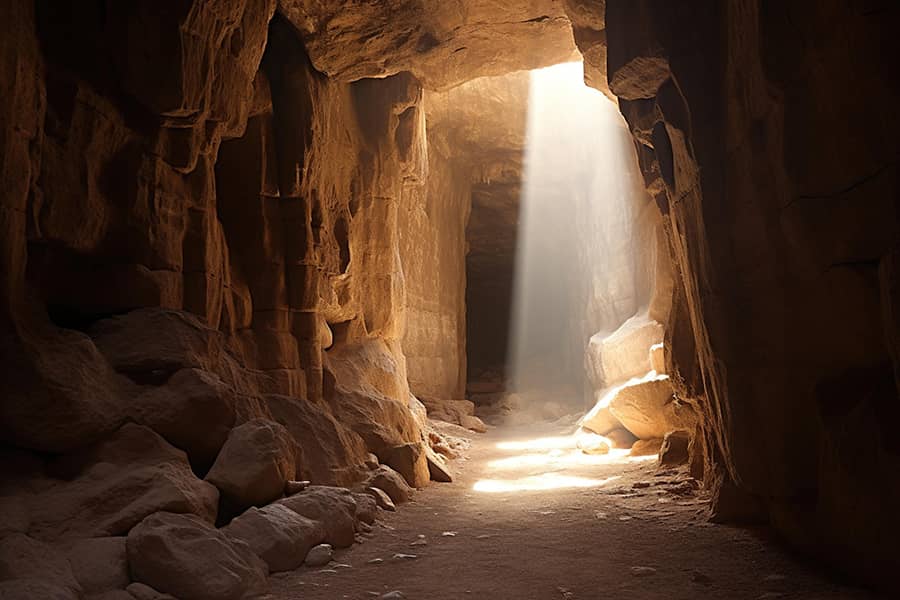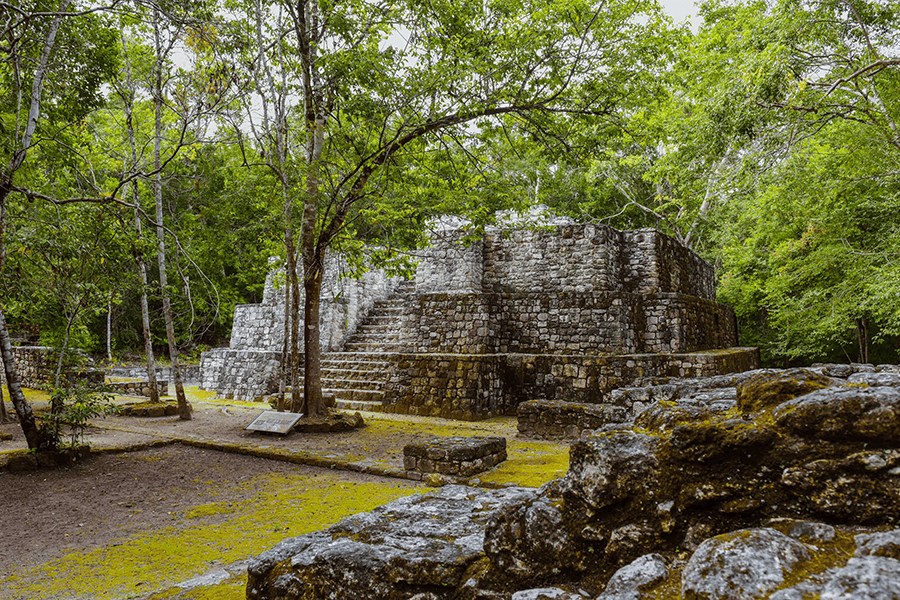A 2,000-year-old burial site containing 12 skeletons has been discovered in Petra, the location where ‘Indiana Jones and the Last Crusade’ was shot.

Uncovering Petra’s Ancient Secrets
Petra, once the thriving capital of the Nabataean Kingdom, is renowned for its stunning rock-cut architecture and water conduit system. However, the recent discovery of a 2,000-year-old burial site containing 12 skeletons offers a tantalizing glimpse into the lives—and final resting places—of those who inhabited this ancient marvel. Each skeleton tells a story etched in bone, hinting at social hierarchies and cultural rituals that may have long been forgotten. As archaeologists sift through these remains, they are not just uncovering bodies; they are piecing together a complex tapestry of identity that reveals how people lived, worshiped, and interacted within this iconic landscape.
What makes this find particularly intriguing is its implications for understanding health and mortality in ancient societies. Preliminary analyses of dental wear and skeletal trauma may reveal insights into daily life risks faced by Petra’s inhabitants—factors ranging from diet to challenges brought on by environmental conditions or conflicts. Furthermore, these remains could provide clues about trade routes and migrations as skeletal isotopes reveal dietary habits based on local crops versus imported goods. Each artifact unearthed alongside these remains contributes to our growing narrative: Petra was not merely an architectural wonder but also a poignant reflection of human resilience, social organization, and even vulnerability against the sands of time.
Historical Significance of Petra
Petra, often referred to as the Rose City due to its stunning pink sandstone formations, serves as a testament to the architectural ingenuity and cultural blending of the Nabataeans. This ancient city was not only a thriving trading hub in the heart of the Arabian Peninsula but also a melting pot of various influences from neighboring civilizations such as Greek, Roman, and Egyptian. The recent discovery of a 2,000-year-old burial site underscores Petra’s significance beyond its economic prowess; it opens windows into the spiritual and funerary practices that shaped Nabataean society.
Each skeleton found tells a unique story woven into Petra’s rich tapestry—perhaps they were merchants who traveled through trade routes or artisans whose craftsmanship adorned this remarkable city. As archaeologists meticulously study these remains alongside artifacts unearthed at the site, they unravel narratives that illuminate daily life in Petra. This exploration not only enriches our understanding of an ancient civilization but also challenges us to reimagine how history is interconnected with our own modern lives—a reflection on how shared spaces can foster diverse legacies across time.
Overview of the Burial Site Discovery
The recent discovery of a 2,000-year-old burial site in Petra offers an intriguing glimpse into the mortuary practices and social structures of ancient civilizations. Unearthed alongside twelve well-preserved skeletons, this site paints a dynamic portrait of life and death in a region steeped in history. Each burial provides critical information about the inhabitants’ beliefs regarding the afterlife, health indicators, and even their diet based on remains found within.
What makes this find particularly captivating is its location near one of the world’s most iconic archaeological sites—where cinematic fantasies were brought to life. The juxtaposition between Hollywood’s portrayal of adventure and the somber reality of historical life opens a dialogue about how we understand our past through popular culture versus academic exploration. Moreover, analysis of these skeletal remains could yield fascinating insights not only into individual lives but also into the broader societal trends during that era, including migration patterns and trade relations with neighboring cultures. As researchers delve deeper into this remarkable discovery, we may uncover stories that have remained silent for centuries, allowing us to connect more profoundly with those who walked these lands long ago.
Details on the 12 Skeletons Found
Excavations at the ancient burial site have unveiled an impressive array of artifacts alongside the twelve skeletons, suggesting that these individuals were part of a society rich in cultural practices and complexities. The positioning of the bodies offers tantalizing clues; several are interred in what appears to be familial clusters, hinting at deep-rooted connections and social structures within this community. Each skeleton exhibits distinct burial ornaments—intricately crafted pottery shards and personal items—that speak volumes about their lives and beliefs.
Interestingly, preliminary analysis suggests a range of ages among the deceased, from infants to older adults. This diversity implies that the site was not only a final resting place but might also hold significance for communal rituals or celebrations. The discovery is particularly riveting considering Petra’s historical role as a crossroads for trade routes; these remnants could provide invaluable insight into how diverse cultures converged in this mystical landscape over two millennia ago. Moreover, as archaeologists delve deeper, they hope to unravel further mysteries surrounding dietary habits and health conditions reflective of life during Petra’s zenith, painting an even richer portrait of its ancient inhabitants.
Archaeological Techniques Used in Excavation
Archaeological excavation in historical sites like the recently discovered burial site in Petra employs a variety of sophisticated techniques that bridge traditional methods with cutting-edge technology. One critical technique is stratigraphy, which involves analyzing the layers of soil and sediment to understand the chronological sequence of human activity. This method allows archaeologists to paint a vivid narrative of how people lived and interacted over thousands of years, revealing insights about societal changes during specific periods.
In addition to manual digging and sifting through materials, modern excavations increasingly rely on non-invasive technologies. Ground-penetrating radar (GPR) can reveal subsurface features without disturbing the ground, offering clues about structures or artifacts hidden beneath layers of dirt. Remote sensing techniques help map large areas quickly before a physical dig begins, enabling researchers to formulate strategies that minimize disruption while maximizing discovery potential. Together, these techniques not only enhance our understanding of ancient cultures but also foster a more respectful approach towards their resting places—ensuring that each find contributes thoughtfully to our collective heritage.
Cultural Insights from the Burial Practices
The recent discovery of a burial site in Petra, housing 12 skeletons dating back 2,000 years, offers a poignant glimpse into the intricate tapestry of cultural practices that defined ancient societies. Analyzing these remains can illuminate not just individual diets and health conditions but also broader social structures. The positioning of the skeletons may hint at familial ties or communal values that transcended mere survival—suggesting that these individuals were interred with care and intention typical of strong kinship bonds.
Moreover, the artifacts found alongside the bodies could reveal significant insights into trade relationships and interactions with neighboring cultures. The presence of certain objects tied to religious or ceremonial beliefs reveals how spirituality permeated daily life and death in this historical milieu. By delving deeper into such burial customs, we can begin to understand how ancient people navigated concepts of mortality; their choices may reflect an acknowledgment of life’s transient nature while simultaneously celebrating connections to future generations and ancestral legacies.
Connection to ‘Indiana Jones and the Last Crusade’
The recent discovery of a 2,000-year-old burial site in Petra transports us back to the adventurous spirit embodied by Indiana Jones and the Last Crusade. Just as Indiana sought out the fabled Holy Grail, this archaeological find invites exploration of human connections with the past—offering us a tangible link to ancient civilizations that thrived long before Hollywood decided to film its epic tales among Petra’s breathtaking rock formations. The juxtaposition of fiction and history prompts intriguing questions about how we mythologize our pasts through cinema while simultaneously excavating them through archaeology.
Moreover, this significant finding echoes the themes of legacy and heritage that coursed through Indiana’s adventures. With each skeleton unearthed, we uncover narratives interwoven with hope, mortality, and cultural identity—much like Professor Jones’s quest for knowledge shaped by his father’s teachings. In dissecting these relics from a time when Petra was a bustling trade hub, we delve into what it means not just to observe history but to engage actively with it—a sentiment echoed in every iconic scene shot against Petra’s striking architecture. As we are reminded of Indiana’s mantra that “There is nothing less important than good intentions,” this discovery serves as a call to approach our understanding of ancient societies with both respect and curiosity, truly now seen in light of their stories begging to be told anew.
Impact on Tourism and Local Culture
The recent discovery of a 2,000-year-old burial site in Petra has not only captured the attention of archaeologists but also reignited interest in this UNESCO World Heritage Site among tourists and culture enthusiasts alike. As travel enthusiasts flock to witness firsthand the rich tapestry of history that permeates Petra’s ancient landscape, local communities stand to benefit from an influx in tourism. This renewed enthusiasm could foster economic opportunities and partnerships, allowing residents to share their heritage while sustaining their livelihoods.
Moreover, as visitors explore these archaeological finds, there’s potential for a deeper engagement with local culture—facilitated through guided tours led by local storytellers who blend historical narratives with contemporary traditions. Such interactions can create a platform for cultural exchange where travelers leave with richer experiences and locals find pride in sharing their identity. In this way, the exploration of ancient sites becomes more than just an expedition; it transforms into a dynamic dialogue between past and present, allowing both visitors and inhabitants to redefine their connections to history.
Future Research Opportunities at Petra
The discovery of the burial site in Petra not only sheds light on the ancient Nabatean civilization but also opens a myriad of avenues for future research that could alter our understanding of this iconic historical hub. Researchers can delve into isotopic analysis of the skeletons to ascertain dietary habits, migration patterns, and even social structures within these communities. This examination could unveil how interregional trade influenced lifestyles and health among those who lived during this pivotal time.
Moreover, advanced technology such as 3D scanning and virtual reconstruction offers exciting prospects for exploring the architectural context surrounding these burials. By mapping out their surroundings, archaeologists might uncover additional artifacts or structures that speak to burial customs or religious practices unique to Petra’s diverse cultural tapestry. Collaborative interdisciplinary studies involving anthropology, archaeology, and bioarchaeology will enrich interpretations and foster a holistic understanding of life—and death—in this storied city.
As anthropologists continue to study these remains alongside local historians, there lies an opportunity for knowledge exchange that honors both scientific inquiry and indigenous narratives. Engaging with descendants of original inhabitants may illuminate cultural continuities while re-examining colonial legacies embedded in archaeological practices challenges researchers to rethink how they document history—a vital step toward honoring the complex heritage alive today in Petra’s vibrant landscape.
Conclusion: (Lessons from the Past)
As we uncover the remnants of a 2,000-year-old burial site in Petra, it’s essential to reflect on what these discoveries teach us about our shared humanity and the cultures that once thrived in this remarkable region. The skeletons serve as poignant reminders that we are all part of an intricate tapestry woven by time, where every life lost carries stories untold. This ancient resting place invites us to contemplate not only the physical artifacts left behind but also the intangible legacies—the beliefs, rituals, and relationships—that shaped these individuals’ identities.
Moreover, examining such archaeological finds highlights the importance of stewardship over our historical narratives. In a world rapidly changing due to globalization and technology, there lies a pressing need to safeguard these sites for future generations. They are not merely relics; they are vital links connecting us with those who walked the earth before us. By embracing lessons from our past—such as resilience in adversity or community bonds during hardship—we can enhance our understanding of contemporary issues while fostering a sense of continuity that enriches modern life amidst its complexities. In doing so, we honor those who came before and ensure their stories remain alive within our collective consciousness.




